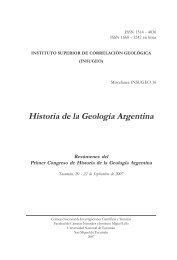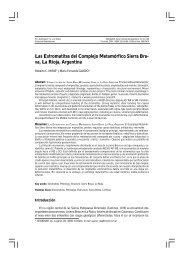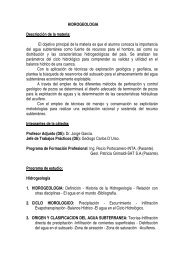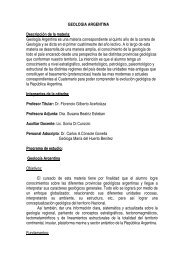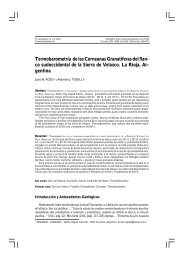Descargue esta publicació en formato pdf haciendo ... - INSUGEO
Descargue esta publicació en formato pdf haciendo ... - INSUGEO
Descargue esta publicació en formato pdf haciendo ... - INSUGEO
You also want an ePaper? Increase the reach of your titles
YUMPU automatically turns print PDFs into web optimized ePapers that Google loves.
Historia de la Geología Arg<strong>en</strong>tina I Serie Correlación Geológica, 24: 9-20<br />
JESUITAS F.G. Aceñolaza Y FÓSILES (Coordinador-Editor) EN LA CUENCA DEL PLATA<br />
Tucumán, 2008 - ISSN 1514-4186 - ISSN on-line 1666-9479 9<br />
Jesuitas y Fósiles <strong>en</strong> la Cu<strong>en</strong>ca del Plata<br />
Eduardo G. OTTONE 1<br />
Chi potrebbe sost<strong>en</strong>ere che tutte le ipotesi ‘’romanzesche’’ siano<br />
state o siano prive di efficacia sulla crescita del sapere sci<strong>en</strong>tifico?<br />
Paolo Rossi, I segni del tempo, p. 128<br />
Abstract: JESUITS AND FOSSILS AT THE CUENCA DEL PLATA.- Petrified wood, shells and bones referred by the Jesuits<br />
Ovalle, del Techo, Sepp, Lozano, Guevara, Sánchez Labrador, Dobrizhoffer, Falkner and Juárez in several texts writt<strong>en</strong><br />
during the XVII and XVIII c<strong>en</strong>turies constitute one of the first records of plant and animal fossils at the Cu<strong>en</strong>ca del<br />
Plata. Most Jesuits considered the Paraná and Uruguay rivers as capable of transforming wood, but also bone, into stone,<br />
and thus, the petrifactions commonly unearthed from their sandy banks as formed by the water. Besides, while Guevara<br />
related to a race of giants, extinct nowadays, the great bones commonly found near the Carcarañá river mouth, Falkner<br />
described a cuirass of glyptodont and Sánchez Labrador explained the pres<strong>en</strong>ce of marine invertebrates on the outskirts<br />
of Bu<strong>en</strong>os Aires by invoking the scriptural Flood.<br />
Resum<strong>en</strong>: JESUITAS Y FÓSILES EN LA CUENCA DEL PLATA.- La madera y huesos petrificados referidos por los jesuitas<br />
Ovalle, del Techo, Sepp, Lozano, Guevara, Sánchez Labrador, Dobrizhoffer, Falkner y Juárez <strong>en</strong> varios textos escritos<br />
durante los siglos XVII y XVIII constituy<strong>en</strong> uno de los primeros registros de plantas y animales fósiles <strong>en</strong> la Cu<strong>en</strong>ca del<br />
Plata. La mayoría de los jesuitas consideraba a los ríos Paraná y Uruguay capaces de transformar la madera y también los<br />
huesos, <strong>en</strong> piedra, y por <strong>en</strong>de, a las petrificaciones comúnm<strong>en</strong>te des<strong>en</strong>terradas de sus barrancas ar<strong>en</strong>osas como formadas<br />
por el agua. Por otro lado, mi<strong>en</strong>tras Guevara relacionaba los grandes huesos comúnm<strong>en</strong>te hallados <strong>en</strong> la desembocadura<br />
del río Carcarañá con una raza extinguida de gigantes, Falkner describía la coraza de un gliptodonte y Sánchez Labrador<br />
explicaba la pres<strong>en</strong>cia de invertebrados marinos <strong>en</strong> los alrededores de Bu<strong>en</strong>os Aires invocando al Diluvio.<br />
Key words: Jesuits. Fossils. Cu<strong>en</strong>ca del Plata.<br />
Palabras clave: Jesuitas. Fósiles. Cu<strong>en</strong>ca del Plata.<br />
Introducción<br />
El adjetivo latino fossilis, desde un punto de vista etimológico, significa ‘‘que se saca de la<br />
tierra’’, y fue usado ya a principios de la era cristiana por Plinio el Viejo (23-70) <strong>en</strong> Natvralis<br />
Historiae, Liber XXXVI: CXXXIV, CLXI, CLXXV y CXCII (Plinio el Viejo 1993); fossilis deriva<br />
a su vez del término griego oryktós, empleado por Aristóteles (384-322 a. c.) <strong>en</strong> el libro tercero de<br />
Meteorologiká (Aristóteles 1996). La palabra fósil habría de utilizarse <strong>en</strong>tonces, aún durante los<br />
siglos XVII y XVIII, para caracterizar a todo tipo de objeto des<strong>en</strong>terrado. Es así que hasta fines<br />
del siglo XVIII algunos naturalistas llegarían a considerar un orig<strong>en</strong> inorgánico para las<br />
petrificaciones de claro aspecto vegetal o animal, <strong>en</strong> tanto que otros relacionarían la pres<strong>en</strong>cia de<br />
invertebrados preservados como moldes o partes duras <strong>en</strong> las sedim<strong>en</strong>titas con el Diluvio o con<br />
grandes inundaciones que habrían cubierto valles y montañas, o bi<strong>en</strong> referirían a una raza extinguida<br />
de gigantes los huesos de vertebrados hallados <strong>en</strong> las rocas (Adams 1938; Guyénot 1957; Céard<br />
1978; Rudwick 1985; Schnapper 1986, 1988; Pelayo 1994; Buffetaut 1998; Rossi 2003; Gould 2004).<br />
1<br />
Departam<strong>en</strong>to de Ci<strong>en</strong>cias Geológicas, Facultad de Ci<strong>en</strong>cias Exactas y Naturales, Universidad de Bu<strong>en</strong>os Aires, Pabellón<br />
nº 2 Ciudad Universitaria, C. P. C1428EHA, Bu<strong>en</strong>os Aires, Arg<strong>en</strong>tina. E-mail: ottone@gl.fc<strong>en</strong>.uba.ar


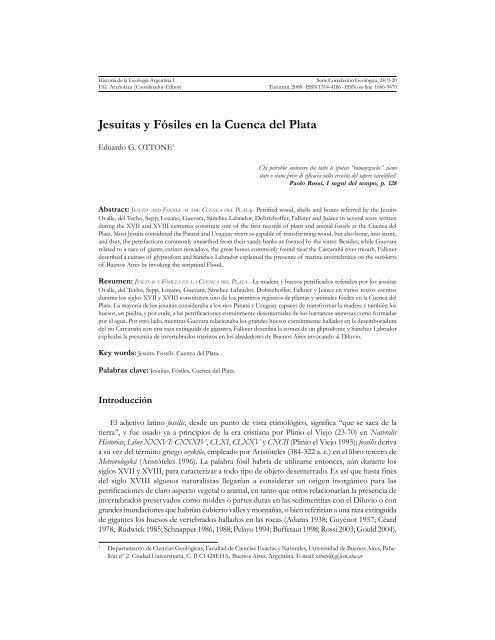
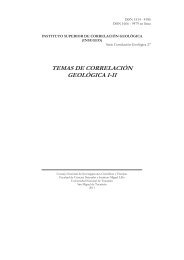
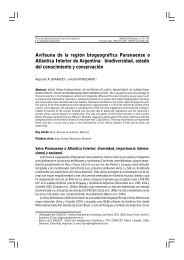

![Descargar El Libro Completo [5.631 Kb] - INSUGEO](https://img.yumpu.com/40710231/1/177x260/descargar-el-libro-completo-5631-kb-insugeo.jpg?quality=85)



